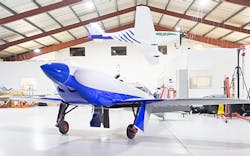The battery design smarts behind Rolls Royce’s ultrafast electric airplane
LONDON, UK - Dozens of electric general aviation projects are underway around the world, not counting the urban air taxis that dominate the electric propulsion R&D scene. The first all-electric commercial aircraft, a seaplane intended for short flights, completed a 15-minute test flight in December, writes Prachi Patel for IEEE Spectrum. Continue reading original article
The Intelligent Aerospace take:
January 29, 2020 -Rolls Royce's quick electric flyer will be powered by a trio of batteries delivering 750kW. Each of the battery packs weigh in at 450kg and stores energy in 6,000 lithium-ion cells.
“Building the world’s fastest all-electric aircraft is nothing less than a revolutionary step change in aviation and we are delighted to unveil the ACCEL project plane," said Rob Watson, Director of Rolls-Royce Electrical. "This is not only an important step towards the world-record attempt but will also help to develop Rolls-Royce’s capabilities and ensure that we are at the forefront of developing technology that can play a fundamental role in enabling the transition to a low carbon global economy.”
Related: Bell and Rolls-Royce collaborate on next-gen VTOL propulsion systems
Related: Rolls-Royce unveils five passenger EVTOL concept
Related: Retired Boeing 747 to become testbed for revolutionary new engines
Jamie Whitney, Associate Editor
Intelligent Aerospace
